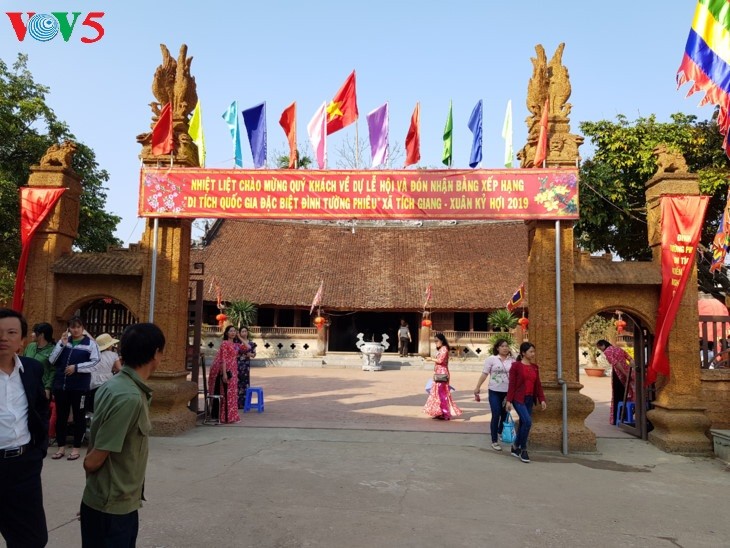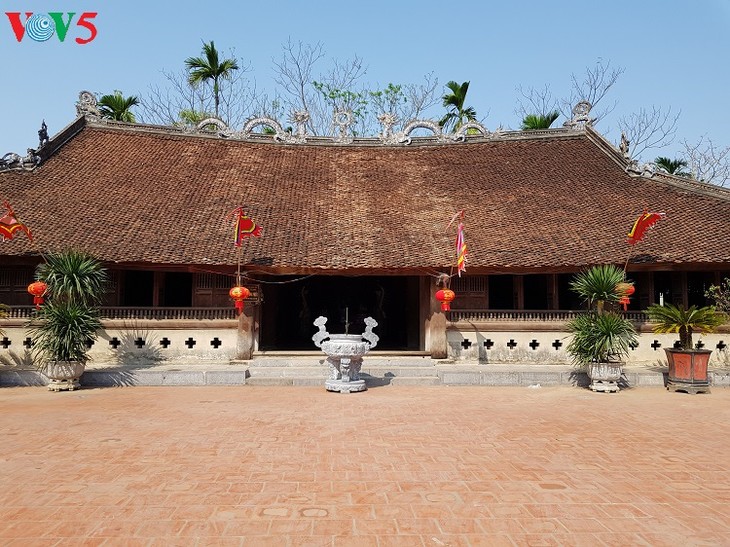(VOVWORLD) - Tuong Phieu communal house in Phuc Tho district, about 40 kilometers west of downtown Hanoi, is the biggest communal house in what used to be Son Tay province. The communal house, which has the typical architecture of the Le dynasty in the 17th and 18th century was recognized as a special national relic in December, 2018.
 Tuong Phieu communal house attracts festival goers of neighboring villages. (Photo: Ngoc Anh) Tuong Phieu communal house attracts festival goers of neighboring villages. (Photo: Ngoc Anh) |
Tuong Phieu communal house was built in 1430 and has undergone several restorations and expansions. The house honors the son-in-law of King Dinh Tien Hoang and the tutelary god of Tuong Phieu village, Saint Tan Vien, who is one of the Four Immortals of Vietnamese folk belief along with Saint Giong, Chu Dong Tu, and the Mother Goddess Lieu Hanh. Saint Tan Vien embodies the aspiration of triumph over natural disasters, especially floods; Saint Giong represents the will to fight off foreign invaders; Chu Dong Tu symbolises love; and Mother Goddess Lieu Hanh symbolizes a rich spiritual life.
Tuong Phieu communal house looks southwest to Ba Vi mountain where the Tan Vien temple is located. Legend says Saint Tan Vien came to this area to teach people to grow rice and and catch fish with a net fastened to one end of a pole.
Khuat Van Thinh, chief manager of cultural relics in Tuong Phieu village, said: “It is believed that Saint Tan Vien taught locals this unique fishing technique in 1432. He returned three years later to observe their fishing and enjoyed a meal with them. That evening they lit torches and held a festival to bid him a farewell back to Ba Vi mountain. On his way home, an orange tornado and colorful clouds appeared and carried him off to his mountain. This caused the villagers to exclaim ‘Tuong Phieu’ which means “a breeze of good fortune”. The village’s name was changed to ‘Tuong Phieu’, after having had several previous names - Ke Queo, Ke Quyt, and Ke Mo.”
 The main house of Tuong Phieu communal house is called "Dai Bai". (Photo: Ngoc Anh) The main house of Tuong Phieu communal house is called "Dai Bai". (Photo: Ngoc Anh) |
Tuong Phieu communal house was built of iron wood, terracotta, and laterite. The gate has two main and two secondary pillars embossed with parallel sentences in Chinese script which praise the enormous contributions of Saint Tan Vien. The main house, made up of five rooms and two small chambers, is a place for worshipping and communal activities. A big altar for Saint Tan Vien in the central room is delicately engraved with a picture of two dragons reporting to the King of Heaven. The altar gratings are also engraved with dragon patterns, a departure from other communal houses.
Nguyen Huy Ngoc, a member of the regional feng shui club, said: “Tuong Phieu communal house has a steep roof, curved at the four corners and crowned with dragons, dragon carps, and crocodiles. Intricate embossments inside the communal house represent dragons, horses, and phoenixes. Precious items preserved at Tuong Phieu communal house include three palanquins, three thrones from the 18th century, an altar, and royal documents of title conferment.”
Four annual festivals are held at Tuong Phieu communal house. The biggest takes place from the 14th to the 16th day of the first lunar month to commemorate Saint Tan Vien’s birthday.
Nguyen Duy Tuc, a Tuong Phieu villager, told VOV: “The Tuong Phieu festivals are held on a larger scale in the years of the Rat, Horse, Cat, and Rooster. Festivities include an offering ritual, art performances, card games, cooking competitions, and sports. The festivals attract crowds of people from neighboring villages.”
Tuong Phieu communal house was recognized last year as a special national relic site.